Lens Below the Waves: The Rise of Underwater Drone Photography
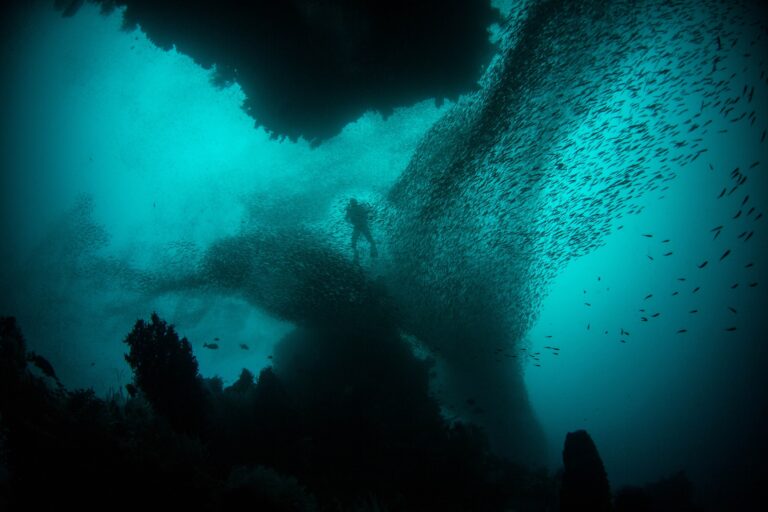
One of our contributors recently wrote about the various aspects involved with capturing the beauty and majesty of the underwater world, and it got us wondering just how we got to have such powerful tools at our disposal.
A Little Background
You might be surprised to hear this, but drone technology has been around longer than most think. While the technology that led to the development of drones started as far back as the 1930s, the kind of technology that we have available today, namely a drone with a camera mounted on it, first saw use by the US military in the Vietnam War. This was the first instance of the widespread deployment and use of drones as dedicated reconnaissance UAVs (unmanned aerial vehicles). Like so many other technologies, today’s consumer-level drones only saw commercial application in the last decade of the 20th century.
Today, drones have flooded the market with many different machines differing in both size and capabilities. Aerial drones range from those that can fit in the palm of your hand, to large vehicles capable of carrying heavy professional-grade cameras that are being used more and more in top-level film productions. They have opened up the possibilities of accomplishing shots that up until quite recently simply wouldn’t have been possible. For an example of this capability, you need to look no further than Micheal Bay’s action romp Ambulance (2022).
For those not in the film industry, the explosion of drone makers on the market has opened up the opportunity for amateur filmmakers and videographers to capture images like never before. Something that previously would have required a helicopter, pilot, and all the costs involved in getting that machine off the ground, can today be done for as little as a couple of hundred dollars. Simply put, drones were a game-changer. And they show no signs of slowing down in their development and application.
While most of us are well aware of aerial drone technology and the fantastic shots being captured of our surroundings from above, what is a little lesser known are those drones designed to work and explore our world, from beneath the surface of the water. Underwater drones, or the more common name of ROVs (remotely operated vehicles), much like their aerial counterparts, have their beginnings rooted in the military. (What would we do without the military?!)
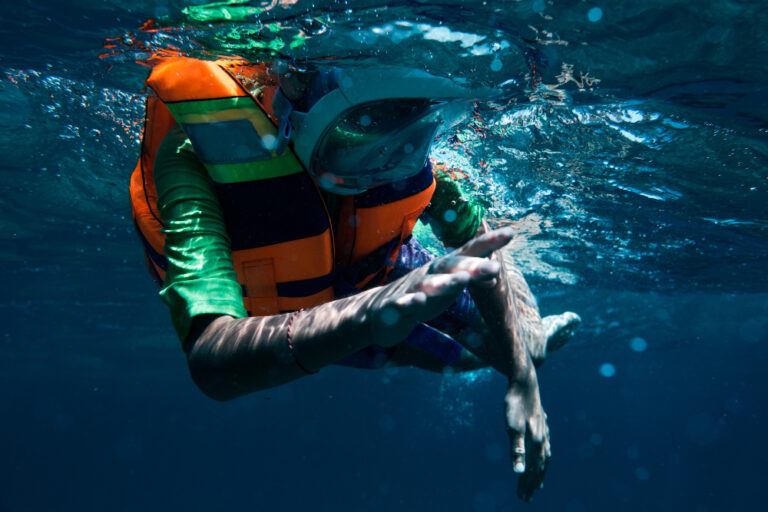
The Underwater Drone is Born
Once again, this technology can be dated back to the 20th century, when in 1953 Dimitri Rebikoff made the first tethered ROV, nicknamed Poodle. Rebikoff was a pioneer in underwater photography, having also invented the first portable underwater flash in 1947, and was the person responsible for the first underwater scooters (which led to the subsequent creation of the above-named Poodle).
Not long after, the US Navy began to experiment and construct vehicles to help them locate and retrieve any ordnance that might have ended up on the ocean floor. This further helped develop the technology of ROVs, with one particular incident involving the retrieval of a nuclear bomb in 1966! Yes, you read that right, the N-word – nuclear. A bomber that had crashed off the coast of Spain, near the town of Palomares, was carrying nuclear ordnance and the navy had employed its Cable-Controlled Underwater Recovery Vehicle (CURV) to bring the bomb back up safely (although, not without consequences for the local population).
Discovering the Titanic
As is often the case, this technology started to be embraced more and more and further improved upon in the 1980s, finding use in areas of scientific research and exploration. Perhaps the most notable use of the technology came about during the search for the RMS Titanic (which wasn’t even the intended mission, as a matter of fact). Thanks to a joint operation between the French and Americans, both teams employed the most advanced and experimental drone technology available. The French had SAR (System Acoustique Remorquè) and the Americans employed their deep-towed sonar and video camera system, called Argo.
Spreading their efforts across a 100 square mile area, the French team had done a lot of coverage with their drone, however without any success. The fate of the discovery lay with the American team and the Argo. At almost the same hour that the ill-fated ship had gone down 73 years prior, the Americans successfully detected one of the Titanic’s boilers on the ocean floor. A key moment that then led the team to the actual wreckage itself, making history and marking the beginning of a new age of underwater exploration. With nearly 170 hours of videotape captured of the East Pacific Rise during the cruise, Argo’s imaging capabilities and value to ocean exploration were undeniable.
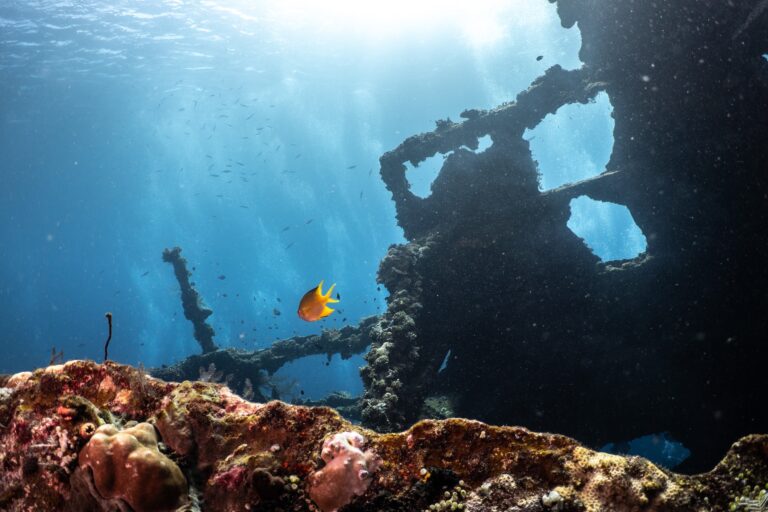
The technology employed in the search would further be implemented by American team leader, Dr Robert D. Ballard who would go on to discover other famous wrecks like the Bismarck, Lusitania and even John F. Kennedy’s PT-109 patrol torpedo boat that had been rammed and sunk by a Japanese destroyer in WW2.
These successes paved the way for further development and more widespread use cases. Come the 1990s, drones were increasingly being used for monitoring underwater equipment, such as those found in offshore oil and natural gas platforms. Likewise, dangerous activities, like the disabling of mines had also been relegated to the humble drone. With increasing developments in lithium-ion batteries, come the early 2000s, underwater drones were becoming far more commonplace, but still in the domain of professionals.
Aerial Drones Take Off
Roughly around this time, specifically, in 2006 there was another significant development, although this time, very much above sea level – the first use of aerial drones for non-military purposes. That same year the Federal Aviation Administration also issued its first commercial drone permit. However, as with most new technologies, it took another decade for the products to become much more affordable and widespread. Fast forward to today, and drones have very much become a part of the photography and videography landscape.
Diving into Underwater Complexities
While nowhere near as ubiquitous as aerial drones, underwater drones have also started to come into their own in the past decade, with several different varieties now available on the market. Much like it is with the aerial kind, underwater drones come in different shapes and sizes, as well as with different operating capabilities.
With all of the challenges that a drone operator needs to deal with above the water, things are no less easy when it comes to underwater exploration. Firstly, you’ve got the ocean itself, probably the greatest natural force on this planet, that presents a whole range of problems for manoeuvring, such as differing temperatures, pressures, and currents, that can negatively affect the navigation and control of underwater drones. However, very much like the aerial variety, more and more manufacturers have come into the arena to tackle these challenges and provide machines that have overcome the lack of GPS (which doesn’t work underwater) and employed different technologies such as inertial navigation systems (INS), acoustic positioning and sonar imaging to enable the operators greater control over their devices and image taking.
Getting into underwater drones presents a greater challenge for most, not only for the environment in which they will be exploring and taking videos and photos, but also for the outlay one would need to make to acquire one. While the average user can get their hands on an aerial drone for a few hundred dollars, the median price of underwater drones tends to be more than their aerial counterparts, as there are more considerations for the device itself, such as making sure the enclosure is both water and pressure-proof. Likewise, the aforementioned lack of GPS makes controlling underwater units that much more difficult and limiting, necessitating the use of tethered cables that usually range up to 100m in length. Incidentally, most underwater drones tend to be rated to a 100m depth, while some of the cheaper varieties are generally limited to half that, or even less in certain models.

Choosing the Right Underwater Drone
Generally speaking, most people’s pockets don’t tend to be lined with money, and for brevity and simplicity, we’ve chosen 3 different models, at three different price points that all present excellent consumer entry points to this exciting technology.
CHASING DORY
Touted as the “smallest, smartest and most affordable underwater drone” the folks at Chasing had produced the amusingly titled “Chasing Dory”. This bright yellow device features a compact form factor (easily handled with one hand) and packs a lot into its diminutive enclosure. It comes with a Wi-Fi buoy which is tethered to the drone and enables the operator to control it via a dedicated app available for both iOS and Android. The maximum depth (as well as the length of the cable) is 15m (50ft).
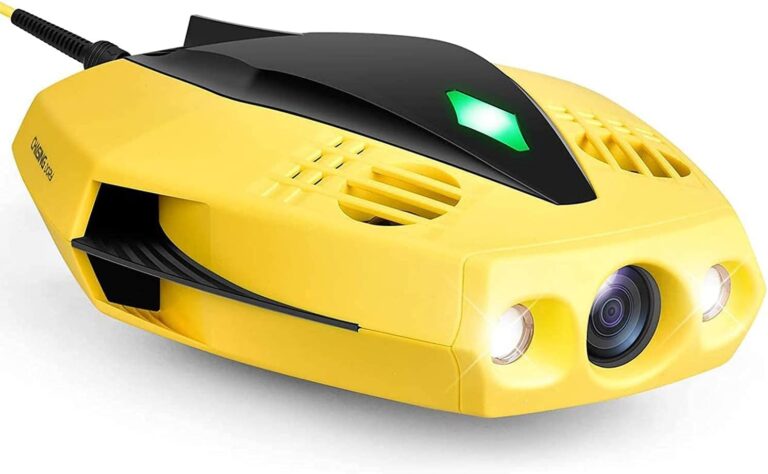
The controller itself is reminiscent of a traditional console game unit and already comes with a stand that is ready to accommodate your mobile phone. The drone also comes with a depth-lock feature, allowing much greater control and stability for underwater image-taking. Compared to some of its bigger siblings, the Dory drone only comes with a 1080p camera that is supported by 500 lumens of light (250 LED lamps on either side of the camera). This perhaps isn’t as impressive as some of the other models we’ll be listing, but those who are just starting and are exploring the relatively shallow depths of the oceans will find that to be perfectly adequate. Likewise, Chasing has also included AI-processing capabilities on the video itself, allowing for on-the-fly colour correction, negating the need for any additional post-processing of the footage.
There are different accessories you can get for your drone, but the lowest price we’ve found for the Chasing Dory standalone unit is $399.00 on Amazon. However, our recommendation is to consider the complete drone set that will set you back $558, which includes all the necessary peripherals to start your underwater exploration.
CHASING GLADIUS MINI S
We’re once again looking at a product from the talented folks at Chasing, the Gladius Mini S. Even though it’s got “Mini” in the title, this is very much the bigger brother of the above-mentioned Dory. However, it’s not that much bigger to make it any less practical. It sports a similar, bright yellow exterior, but with a slightly larger body and presents a further evolution of the Dory model (or rather, Dory presents a scaled-down version of the Gladius), both in its range and capabilities.
Sporting a 4K UHD camera, the Gladius is also able to wade to a depth of 100m, along with the provided tethered cable that comes with the machine.
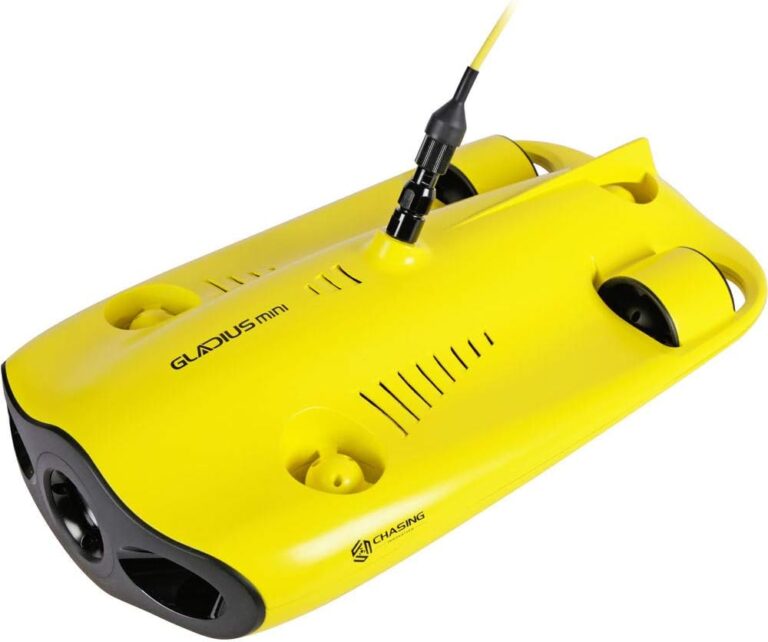
Like Dory, this also features depth-lock and the unit comes equipped with 64GB of SD storage for recording that is also capable of taking cards of up to 512GB. The more advanced camera is also backed up by two 1200-lumen lights, giving the user a much brighter final image. The controls themselves, are once again done via a dedicated app, however this time around, the user has the option of controlling the unit with VR capabilities, having the ability to turn and look in a certain direction with the drone mimicking the movements underwater.
Due to its larger form factor and generally higher specs, the Gladius can attach external peripherals, such as a Go-Pro camera or a custom robotic arm that can be used to retrieve objects to the surface. As is the case with the Dory drone, the Gladius also comes as a standalone product that will set you back $999.00 on Amazon, but if you want the complete package that includes all the necessary components that will make your underwater photography shine, it is best to choose the upgraded package for $1399.00 that includes not only the robotic arm, but also a premium backpack that is custom-made to perfectly fit all the components of the system.
Qysea Fifish V-EVO
The last model we’ll be looking at today is the Qysea Fifish V-EVO (formerly the V6S), coming equipped with a fully-powered robotic arm that is capable of over 5kg (11 lbs) of gripping force. This addition is already showing the more serious intent of this particular drone. Not only can you use it for underwater filming and photography, but you’re also able to employ it for salvage and rescue missions, structural inspections, offshore maintenance work and aquaculture.
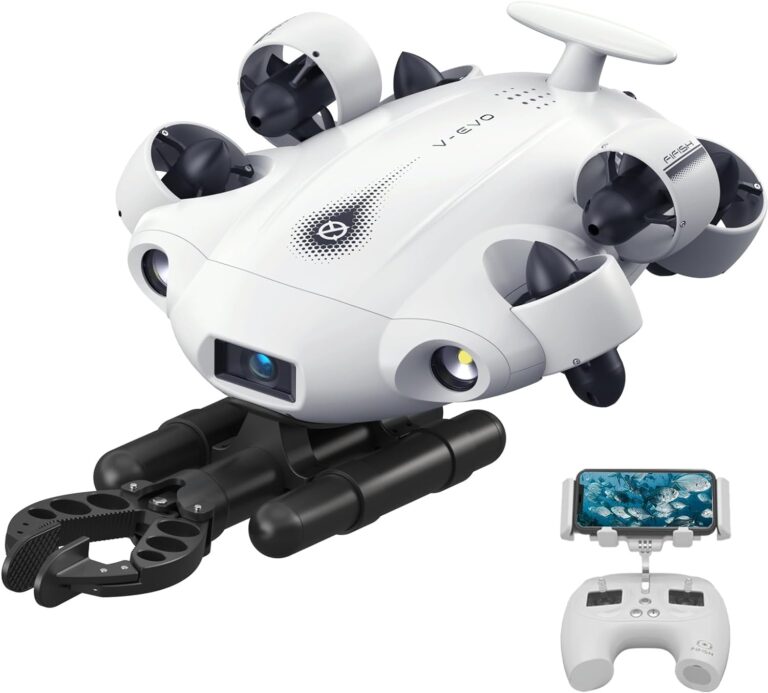
The V-EVO also comes with longer-lasting batteries, allowing for up to 4 hours of dive time. Likewise, the improved battery technology also allows for faster charging times once depleted. The unit comes equipped with a 4K camera as standard, flanked by two 2500-lumen lights on either side of its bright, white paintwork. In all fairness, we prefer the once bright fluoro-green paintwork of the previous incarnations of the model, however, you can still see remnants of this colour scheme in the cables offered by Qysea. One particularly impressive option with the V-EVO is the ability of VR head tracking (the drone ‘looks’ with you), although this requires the addition of goggles for the piloting.
Not surprisingly, the Fifish V-EVO is the most expensive of the three options presented today, however, it’s also easy to see why, especially when we take into consideration the capabilities of that robotic arm. In one particular test, the drone successfully retrieved a 10kg kettlebell. Anyone who might be thinking about looking for and finding some sunken treasure, already has a distinct leg-up with such a device in their arsenal. Qysea offers even more advanced models, however, we think that this one strikes the best balance of features vs price. As was the case with the above models, you can buy the unit separately for $1299.00, but your best bet would be to grab the robotic arm version that retails for $1599.00 (at the time of writing).
What’s Next for the Underwater Drone?
As we’ve already mentioned, we didn’t want to get into discussing too many different models for the sake of brevity, however, other companies out there have also made steady progress in the underwater arena. One notable mention is iBubble, made by the French company Notilo Plus. Their underwater drone claimed to be “the first wireless and autonomous drone in the world”, but, since December 2022, the company has stopped selling the model until further notice. This is an incredible feat, as you’ve undoubtedly realised already, the biggest hurdle facing most drones is precisely the need to keep them tethered and for the control of the drone to be possible.
Curiously, when visiting the website, you’re also greeted with the message that the company had been acquired by Delair, but if you visit the Seasam site, you can see the original iBubble on offer, although this time in a different colour than the original (orange, as opposed to the bright yellow paintwork). We can only hope that the talents behind that original creation are working hard at improving the designs of this new incarnation and that perhaps, their advanced remote-operated, wireless capabilities are just what the industry needs.

Much like their aerial counterparts, underwater drones offer us an amazing opportunity to capture and explore areas that we never would have been able to otherwise. The oceans are not only teeming with life forms of all shapes and sizes, but likewise, many mysteries and secrets that have been hiding beneath the surface for millennia. The question remains, are you going to be the next Dr Robert D. Ballard and discover that long-lost shipwreck or ancient temple? There’s only one way to find out – and fortunately, thanks to the efforts of companies like Chasing and Qysea, the price of entry to this underwater adventure is becoming more affordable than ever before.
